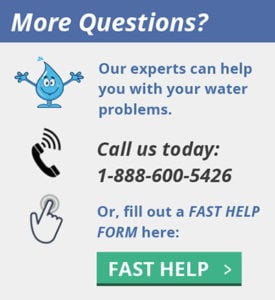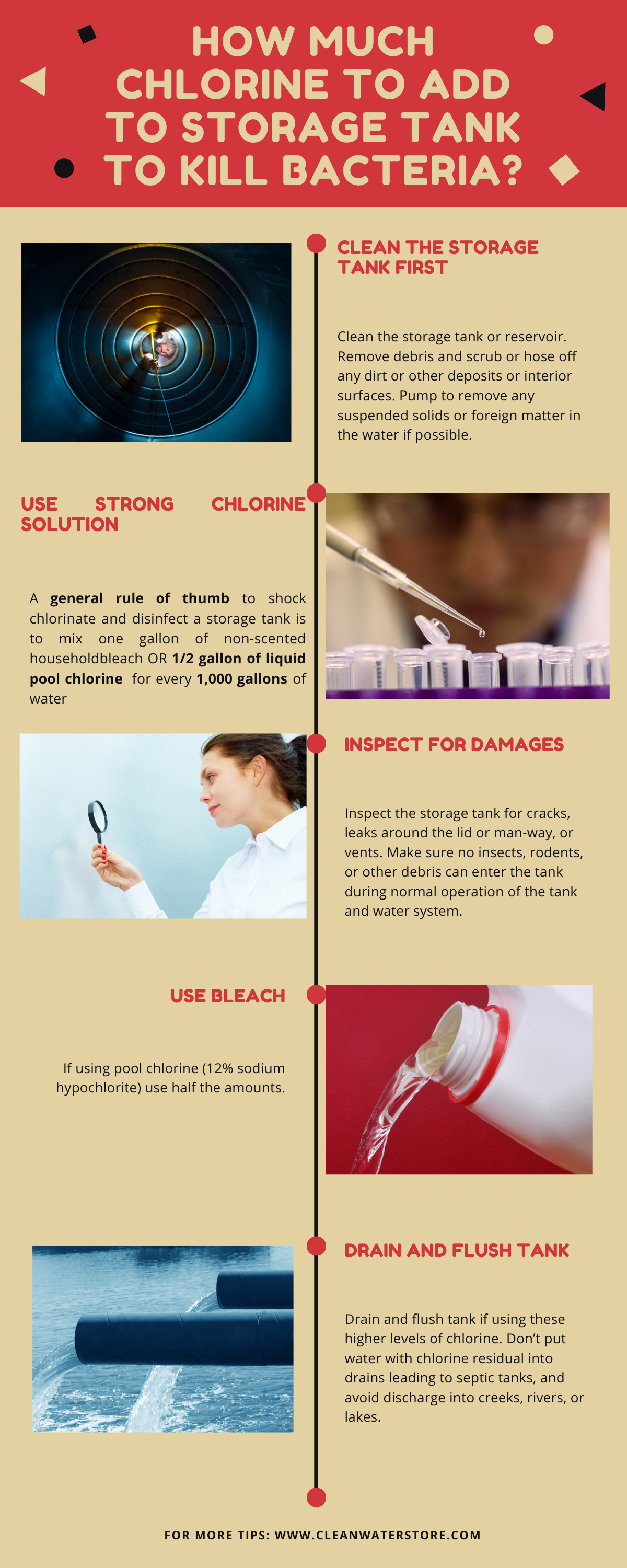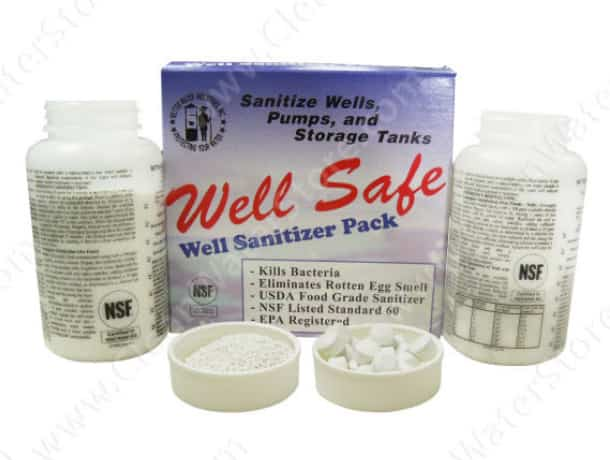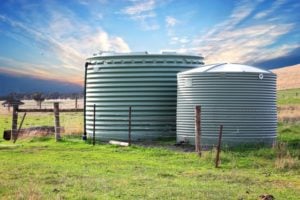
How much chlorine is needed to treat water?
How much chlorine bleach do I put in my water tank?
Also known as ‘chlorine shock”, this article can show you how much chlorine shock to use. To do a chlorine shock you can use liquid chlorine (bleach) or granular chlorine.
Using the charts below you can find out how much Chlorine Bleach is needed to disinfect and purify specific quantities of water, for example, 1,000 gallons. Whether you have a 350 gallon tank, a 600 gallon tank or a 1000 gallon tank or larger it is easy to know how much to add to your water storage tank.
On this page, we will talk more about the chlorine-to-water ratio and how much chlorine to put in drinking water.
If your water storage tank is new, has been worked on recently, or you know it is contaminated, perform a “shock chlorination” with 50 to 100 parts per million (PPM) and let sit for 12 to 24 hours.
After you add the chlorine, the chlorine levels will start to drop. Chlorine is used up and breaks down depending on the chlorine demand (your water's chemistry and conditions) and the temperature of the water.
Test the chlorine residual after 24 hours and if the chlorine levels are 10 PPM or less, repeat the procedure. If you are storing water and want to keep a chlorine residual to be safe, use a maintenance residual of 1 – 2 PPM.
Two Methods: Shock Chlorination Or Chlorine Maintenance Residuals
Shock Chlorination
Shock chlorination adds chlorine until the residual reaches 50 to 100 PPM. This is recommended when you have a new storage tank or have work done on the well, or find out the storage tank is contaminated with coliform bacteria.
Shock chlorination will make the water unusable for potable use until the chlorine levels drop below 2–4 PPM, which typically occurs within a few days to a few weeks depending on temperature and water chemistry.
Maintenance or Low-Level Chlorination
Don’t want to use shock chlorination? It is best to use an automatic chlorinator if you wish to automatically maintain a chlorine residual to keep your storage tank disinfected as freshwater flows into it.
However, if your storage tank is for long-term storage or you wish to periodically chlorinate see the chart for adding 1 – 2 PPM.
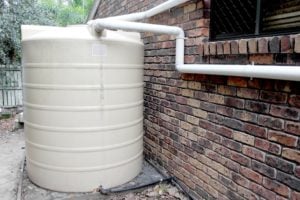
A chlorine residual of 1 to 2 PPM is recommended if you plan to maintain a chlorine residual for potable water use. Follow these steps and see the chart below to find out how much chlorine bleach to add to achieve these residuals.
Step 1: Clean The Storage Tank First
Clean the storage tank or reservoir. Remove debris and scrub or hose off any dirt or other deposits or interior surfaces. Pump to remove any suspended solids or foreign matter in the water if possible.
Step 2: Use Strong Chlorine Solution
If possible, scrub the interior surfaces of storage or reservoir if applicable with a strong chlorine solution containing ½ gallon of household bleach, or ¼ gallon of pool chlorine to every 5 gallons of water.
Make sure there is adequate ventilation. Enclosed spaces are dangerous and can cause illness or death.
Step 3: Inspect For Damages
Inspect the storage tank for cracks, leaks around the lid or man-way, or vents. Make sure no insects, rodents, or other debris can enter the tank during normal operation of the tank and water system, by making sure the lid is tight-fitting, and any vents are properly screened.
Use the chart below to decide how much chlorine bleach to put in the water tank, to bring up the chlorine residual in the tank to the desired level.
For example, you can use the chart below to find out how much bleach to disinfect 1,000 gallons of water and what chlorine to water ratio is needed to treat water.
NOTE: If you need to use the water in the tank immediately after chlorination, consider adding enough chlorine to bring the levels up to 5 or 10 ppm and let sit for 12 hours or more. Use 50 to 100 PPM chart only if you are doing shock chlorination for new or heavily contaminated storage tanks.
Storage tanks: Disinfecting with liquid household bleach (5.25% Sodium Hypochlorite)
Step 4: Use Bleach
If using pool chlorine (12% sodium hypochlorite) use half the amounts below.
| Storage Tank Gallons | Approx. parts per million of chlorine residual achieved by adding 5% chlorine bleach, in the amounts below. Numbers are rounded for easier measuring. 1 Tablespoon = 0.5 ounce. | |||||
| 1 PPM | 5 PPM | 50 PPM | 100 PPM | 200 PPM | ||
| 10,000 | 25.5 oz | 1.0 gallon | 10 gallons | 20 gallons | 40 gallons | |
| 5,000 | 12.5 oz. | 1/2 gallon | 5 gallons | 10 gallons | 20 gallons | |
| 2,500 | 6.5 oz | 32 oz | 2.5 gallons | 5 gallons | 10 gallons | |
| 1500 | 3.8 oz | 19 oz | 1.5 gallon | 3 gallons | 6 gallons | |
| 1000 | 2.5 oz. | 12.8 oz. | 1.0 gallon | 2 gallons | 4 gallons | |
| 500 | 1.3 oz | 6.4 oz | 0.5 gallon | 1 gallon | 2 gallons | |
| 250 | 4 teaspoons | 3.2 oz | 4 cups | 0.5 gallon | 1 gallon | |
| 100 | 1.5 teaspoons | 1.3 oz | 1-1/2 cups | 0.2 gallon | 0.4 gallon | |
Step 5: Drain and flush tank
Drain and flush tank if using these higher levels of chlorine. Don’t put water with chlorine residual into drains leading to septic tanks, and avoid discharge into creeks, rivers, or lakes.
Be careful if you have a steel storage tank, as corrosion may have occurred over time, and once the tank is cleaned it may develop leaks.
A general rule of thumb to shock chlorinate and disinfect a storage tank is to mix non-scented NSF-approved household bleach (5.25% chlorine) in the reservoir at the ratio of 1 gallon of bleach for every 1,000 gallons of water (i.e., 1 quart for every 250 gallons of water).
This will give a chlorine concentration of 50 ppm, far higher than the 0.5 to 2.0 PPM found in treated city water, and make the water unusable for potable water use until residual drops down to less than 4.0 PPM.
For storage tanks or cisterns fed by well water: Add bleach directly to the storage tank at the same time, you are disinfecting the well. Let the storage tank drain into the distribution system.
After sitting for 12 to 24 hours, drain the storage tank through a drain valve or through the distribution system.
Do not dispose of chlorinated water into a septic tank or on vegetation or into surface water.
If you cannot find NSF-certified chlorine bleach use NSF-certified chlorine pellets or powder.
Click to see Well Safe Sanitizer Kit.
Using Calcium Hypochlorite Granular or Pellets
Storage tanks: disinfecting with dry 1 gram chlorine pellets, or chlorine granules. Do not use pool bleach. Use calcium hypochlorite for potable water.
| 1 cup pellets = 200 pellets = 1/2 lb | 2 cups pellets = 400 pellets = 1 lb |
| 25 pellets in 100 gallons = 50ppm | 50 pellets in 100 gallons = 100ppm |
| Storage Tank Gallons | Approx. parts per million of chlorine residual achieved by adding dry chlorine pellets in the amounts below. | |||||
| 1 PPM | 5 PPM | 50 PPM | 100 PPM | 200 PPM | ||
| 10,000 | 1 cup | 2.5 cups | 5 lbs | 10 lbs | 30 lbs | |
| 5,000 | 1/2 cup | 1.3 cups | 5 cups | 5 lbs | 15 lbs | |
| 2500 | 30 pellets | 2/3 cup | 2.5 cups | 5 cups | 15 cups | |
| 1500 | 18 pellets | 1/4 cup | 1.5 cups | 3 cups | 9 cups | |
| 1000 | 12 pellets | 32 pellets | 1 cup | 2 cups | 6 cups | |
| 500 | 6 pellets | 16 pellets | 1/2 cup | 1 cup | 3 cups | |
| 250 | 3 pellets | 8 pellets | 1/4 cup | 1/2 cup | 1.2 cups | |
| 100 | 1 pellets | 3 pellets | 25 pellets | 1/4 cup | 1/2 cup | |
| Useful Measurements: | |
| 1 cup = 8 fluid oz. | 1 pint = 16 fluid oz. |
| 1 quart = 32 fluid oz. | 1 gallon = 128 fluid oz. |
| 1 teaspoon = 1/6 fluid oz. | 3 teaspoons = 1 tablespoon |
| 1 fluid oz. = 29.6 milliliter (ml) | 20 drops = 1 ml. |
What Type of Chlorine Is Best to Use?
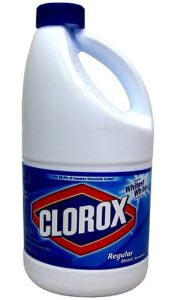
Besides knowing how much chlorine to put in water storage tank, you also need to decide on which type of chlorine to use.
There are three main types of bleach available to use to sanitize your water storage tank.
The worst option is to use household laundry bleach, Clorox. This contains unwanted chemicals besides chlorine. Laundry bleach does work and will disinfect your storage tank, so that is an option. Make sure to use non-scented.

The best chlorine bleach that is certified for drinking water. If you cannot find liquid bleach that is NSF certified you can use dry NSF pellets or powdered bleach.
A second good option is to use liquid pool chlorine, which is sodium hypochlorite without additives (unlike laundry bleach). You can usually find liquid pool chlorine at Home Depot or Lowe’s or hardware stores and also spa and pool supply companies. Pool chlorine is liquid 10-12% sodium hypochlorite, which means it has 10 to 12% chlorine.
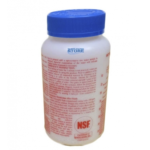
An easy-to-use NSF-certified chlorine bleach is chlorine granules with no additives. This type is calcium hypochlorite and can be mixed with warm water and put into storage tank.
Do not use dry powdered pool chlorine, sometimes known as Tri-Chlor in your storage tank or well water.
Which Chlorine Test Kit Should I Use?
After you figure out how much chlorine to put in water storage tank, you may want to have a chlorine test kit on hand to know the chlorine residual after you have chlorinated your storage tank.
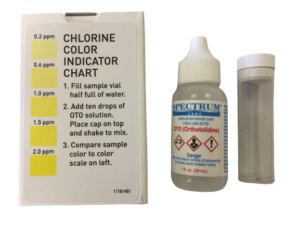
Having test kits offer two main benefits:
- You can tell if you have added sufficient chlorine to your tank because you can measure the chlorine levels.
- You can know when the chlorine has dropped to safe levels (less than 4.0 PPM) if you need to use the water in the home.
There are two main types of chlorine test kits for easy home use, and they are liquid drop types (which use reagents that you drop into a test tube) and test strips.
A common low-range chlorine test kit uses Orthotolidine which turns yellow if chlorine is present so it is easy to use.
Test strips are easier to use but for low range, the reagent type may work better in our experience.
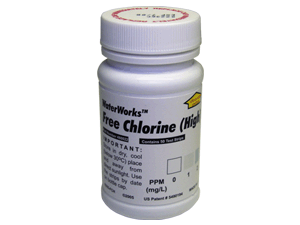
You also may want a High Range Kit if you are “shock chlorinating” the tank with high levels of chlorine over 5 PPM.
A low range kit allows you to check for chlorine levels if you are adding chlorine to maintain a low level residual, or you want to know when it is safe to use the water.
Is Chlorine Dangerous or Bad for My Health?
According to the CDC and World Health Organization and health authorities, chlorine levels up to 4 milligrams per liter (mg/L or 4 parts per million (ppm)) are considered safe in drinking water. At this level, harmful health effects are unlikely to occur.
There are studies that show that showering and drinking chlorinated water over your lifetime may increase your chance of getting some cancers, however adding chlorine to kill bacteria in your storage tank and then draining the water out will not have any health effects.
In municipal treatment plants, chlorination is the process of adding chlorine to drinking water to kill parasites, bacteria, and viruses. Different processes can be used to achieve safe levels of chlorine in drinking water. Using or drinking water with small amounts of chlorine does not cause harmful health effects and provides protection against waterborne disease outbreaks.
Water comes from a variety of sources, such as lakes and wells, which can be contaminated with germs that may make people sick. Germs can also contaminate water as it travels through miles of piping to get to a community. To prevent contamination with germs, water companies add chlorine to keep water safe.
Liquid bleach and chlorine powders and pellets can be hazardous to work with unless you use some common sense precautions. Use gloves and eye protection and avoid breathing chlorine fumes or exposing your skin to chlorine.
Does Chlorine Kill all Bacteria?
The Efficacy of Chlorine in Water Treatment: Chlorine is a powerful disinfectant widely used in water treatment to eliminate harmful bacteria and other microorganisms. Its effectiveness is attributed to its ability to disrupt the cell walls of bacteria, rendering them harmless. This makes chlorine a critical component in ensuring water safety, especially in storage tanks.
Chlorine Concentration and Safety: As we noted earlier above, it is critical to acheive the appropriate chlorine concentration, typically between 1 and 2 parts per million (PPM), for potable water. This concentration is effective in killing bacteria while remaining safe for human consumption. However, it's essential to balance the dosage and contact time correctly. For example, shock chlorination, which uses a higher chlorine concentration (50 to 100 PPM), is recommended for treating new or contaminated tanks but requires the chlorine levels to drop before the water becomes potable again.
Limitations of Chlorine in Achieving Sterility: While chlorine is effective in killing bacteria, it's important to note that the treated water is not rendered sterile. To achieve water that is completely free of bacteria, additional purification steps are necessary after chlorination. These steps can include methods like ultraviolet sterilization, which uses UV light to further disinfect the water or advanced filtration techniques.
Advanced Filtration Techniques: Filtration methods such as using a nano-ceramic filter cartridge or an ultra-filtration membrane can effectively remove any remaining microorganisms from the water. These methods work by physically filtering out bacteria and other pathogens, providing an additional layer of safety and ensuring that the water is as free from bacteria as possible.
What about Hydrogen Peroxide? Can I Use Peroxide Instead of Chlorine?
You might wonder if peroxide can be used instead of chlorine to sanitize your storage tank but this won't work.
You can use hydrogen peroxide on cuts or abrasions to kill germs but it is not a good disinfectant for drinking water. Hydrogen peroxide is rarely used in drinking water as a stand-alone treatment process. It’s a very weak biocide compared to chlorine or ozone.
It’s not approved by the EPA and other health authorities as a stand-alone disinfection treatment process. Hydrogen peroxide is great for removing odors and making water taste better but it is not useful for the disinfection of storage tanks.
Email our technical support department at [email protected] or call us for help at 1-888-600-5426!

